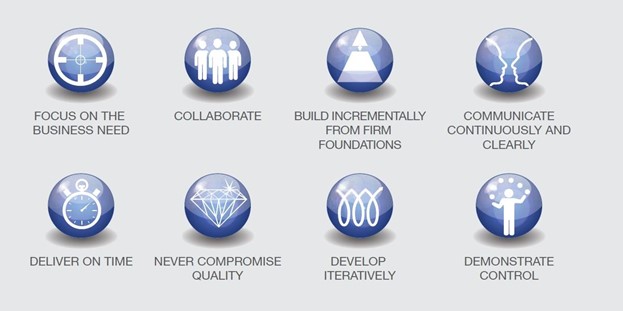The World’s Leading Framework and Certification for Agile Project Management
By APMG International
July 26, 2023
Agile’s influence on the project management industry continues to rise at pace. Organizations and project professionals are embracing Agile tools and frameworks as they aim to increase the success of – and return on investment from – projects and other change initiatives. Key benefits often attributed to Agile include improved revenue and speed to market, development of the right products/solutions (through iterative development and incremental delivery), and increased collaboration and customer satisfaction. Since its introduction in 2010, AgilePM has fast established itself as the leading framework and certification for agile project management.
Based on the Agile Business Consortium’s Agile Project Framework, AgilePM guidance (through the AgilePM Handbook) offers a practical and repeatable methodology that achieves an ideal balance between the standards, rigor and visibility required for good project management, and the fast-pace, change and empowerment provided by Agile. AgilePM offers a structured and scalable corporate Agile framework based on proven practice. So why should organizations and project professionals consider AgilePM to support their adoption or improvement of agile project management practices?

A Tried and Tested Corporate Approach
The AgilePM methodology is essentially a project manager’s subset of the Agile Business Consortium’s wider Agile Project Framework. The framework – established for over 20 years and regularly refreshed to reflect current practices and business requirements – provides governance and rigor along with the agility and flexibility demanded by organizations today. AgilePM and the underlying Agile Project Framework have been adopted as the chosen approach by a wide range of organizations representing various sectors and industries.
Addresses the Full Project Lifecycle (Beyond Product Development)
For organizations delivering projects and programmes, and where existing formal project management processes already exist, the informality of many of the agile approaches is daunting and sometimes perceived as too risky. AgilePM offers a mature approach that, whilst offering agility and flexibility, retains the concepts of a project, project delivery and project management.
Inclusion of Chance Management Activities
AgilePM goes further than other project management approaches because it has a specific process for considering how what has been created will be implemented. This Deployment step is integral to the AgilePM lifecycle and ensures that there is a focus on how to support users once the deliverables are made available to them.
Quality and Governance Controls
One of AgilePM’s underlying principles is to Never Compromise Quality. In an AgilePM project, high-level acceptance criteria are agreed at various stages throughout the project lifecycle, from high-level criteria at the feasibility stage, to objectives for each stage of product/solution development. The responsibility for ensuring that what has been created meets its quality criteria is a core part of all roles, and quality is understood before any work is undertaken, so everyone knows what good should look like before they start work. This is a far more efficient approach than rejecting work after it has been created because it doesn’t meet quality criteria that were not clear at the start. This is all geared to ensuring the solution will meet the business need and the project objectives.
Risk Management
AgilePM provides practical ideas for managing risk, directly addressing many of the common risks for projects (e.g., missing fixed deadlines, or having unclear or volatile requirements). The Project Approach Questionnaire provides an effective starting point for creating a clear, shared understanding of project risks and their mitigation.
Clear Roles and Responsibilities
People working together effectively are the foundation of any successful project. AgilePM recognizes this and assigns clear roles and responsibilities to each person in a project, representing the business interests, the solution/technical interests, the management interests, and the process interests. Everyone involved in an AgilePM project works closely together in order to break down potential communication barriers, with the best solutions emerging from self-organizing, empowered teams.
Popular Agile Practices Incorporated
AgilePM incorporates and encourages a range of popular agile practices to support effective product and solution development. These include MoSCoW Prioritization (a technique for helping to understand and manage priorities), Timeboxing (a Timebox is defined as a fixed period of time, at the end of which an objective has been met), and Iterative Development (a process in which the evolving solution, or part of it, evolves from a high-level concept to something with acknowledged business value).
Integrates With Existing Processes
Whilst AgilePM can be utilized as a stand-along approach to project management, it has been designed pragmatically to work alongside more formalized project management approaches such as PRINCE2® and can be dovetailed into formalized quality processes such as ISO9001.
AgilePM Principles
The AgilePM framework is underpinned by the Agile Business Consortium’s eight principles for effective agile project delivery:


The eight principles are designed to support the Agile Business Consortium’s underlying philosophy that: “Best business value emerges when projects are aligned to clear business goals, deliver frequently and involve the collaboration of motivated and empowered people.”
The AgilePM framework is supported by accredited training and certifications via APMG. Over 150,000 exams have been taken globally since 2011 with numbers increasing rapidly year-on-year, and candidates representing a broad range of organizations and industries. APMG’s global network of accredited training organizations (ATOs) offers a range of training options to suit specific candidate and client requirements. You can find their details via the APMG website (www.apmg-international.com/agilepm)

Check out IIL’s AgilePM Foundation Course here! IIL is an APMG Accredited Training Organization (ATO).
IIL’s Agile and Scrum Online Conference is available to stream now through September 4th! Register here.
AgilePM® is a registered trademark of Agile Business Consortium Limited. All rights reserved. The APMG International AgilePM and Swirl Device logo is a trademark of The APM Group Limited, used under permission of The APM Group Limited. All rights reserved.
Disclaimer: The ideas, views, and opinions expressed in this article are those of the author and do not necessarily reflect the views of International Institute for Learning or any entities they represent.


